Leaning Tower of Power: The Chrysler Slant 6 Story
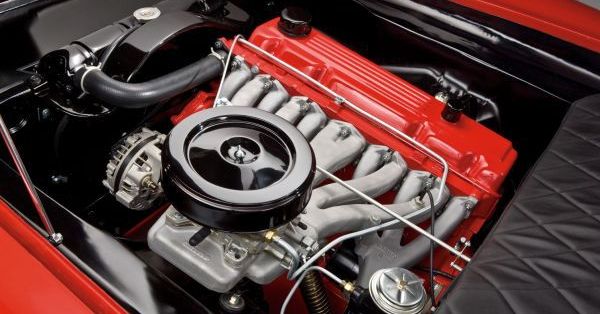 Chrysler’s
Slant 6 of 1960-1987 is remembered today as one of the most rugged and
dependable engines in Motor City history. Here’s the story behind the
indestructible Mopar six.
Chrysler’s
Slant 6 of 1960-1987 is remembered today as one of the most rugged and
dependable engines in Motor City history. Here’s the story behind the
indestructible Mopar six. All through the 1950s, the Chrysler Corporation was noted for its engineering leadership and cutting-edge, high-performance V8 engines like the legendary Hemi. But oddly, the automaker’s six-cylinder offerings were antique L-head designs that dated back to well before World War II.
Overweight, bulky, and inefficient, the creaky old L-Head was totally unsuited for the all-new Valiant compact being readied for the 1960 model year. Chrysler’s engine specialists stepped up and designed an equally new and innovative powerplant for the Valiant, the Slant 6, which was then adopted by the company across the board. Along the way, the Slant 6 developed a reputation as one of the most rugged and reliable engines the Motor City has ever produced. Here’s the story.
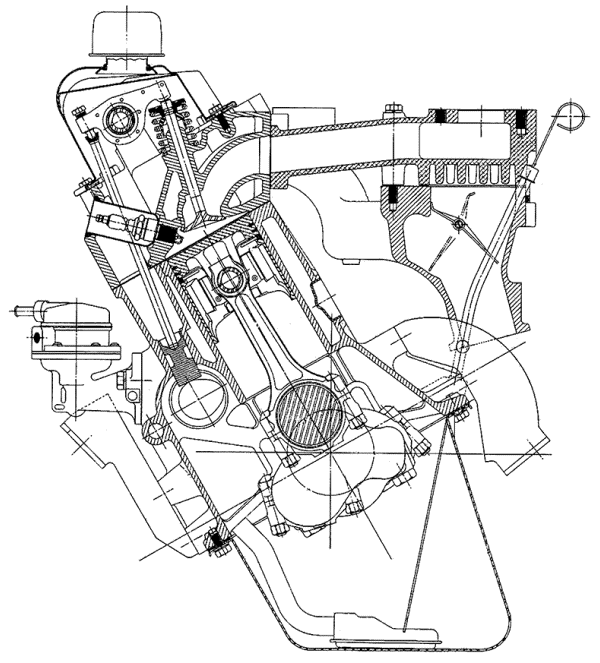 Lead
engineer on the Slant 6 project was Chrysler engine wizard Willem
Weertman, then the company’s manager of engine design, and he began with
a clean sheet of paper, taking nothing from the old flathead sixes. Of
course, the engine’s most notable feature was its canted block with the
cylinders laid over 30 degrees to the right. This permitted a
significantly lower cowl and hood height, a key element in the Valiant’s
distinctive styling, and it also made room for long, straight intake
manifold runners for improved fuel/air distribution, a traditional
trouble spot in inline-six layouts.
Lead
engineer on the Slant 6 project was Chrysler engine wizard Willem
Weertman, then the company’s manager of engine design, and he began with
a clean sheet of paper, taking nothing from the old flathead sixes. Of
course, the engine’s most notable feature was its canted block with the
cylinders laid over 30 degrees to the right. This permitted a
significantly lower cowl and hood height, a key element in the Valiant’s
distinctive styling, and it also made room for long, straight intake
manifold runners for improved fuel/air distribution, a traditional
trouble spot in inline-six layouts.While everyone knows the Slant 6 name today, it took a few years to catch on completely, even within the company. Initially, Plymouth branded the engine as the 30-D, referring to the cylinder bank angle—not nearly as catchy, we can agree. Two displacements were initially offered: a 170 CID model for the Valiant with a 3.40-in. bore and 3.125-in. stroke, and the 225 CID unit, which used a long 4.125-in. stroke and a tall-deck block to power the full-size sedans.
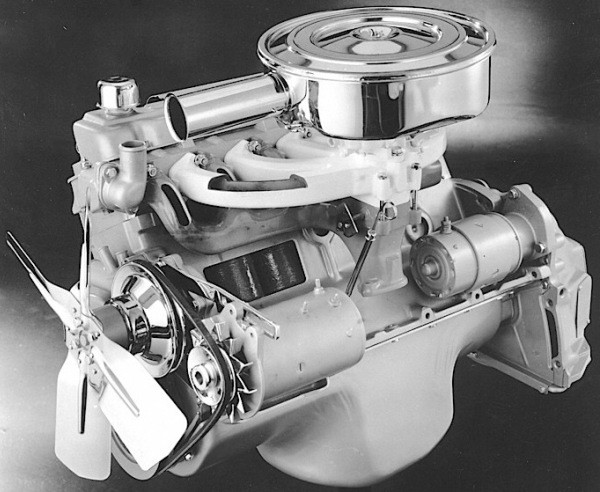 While
the canted block provided an obvious advantage in reduced height, there
was another less obvious but equally important benefit. With the
cylinders laid over 30 degrees, the water pump could be placed alongside
the block instead of in front, shortening the engine’s footprint by a
good four inches. Four main bearings also helped to keep engine length
to a minimum, while the sturdy, deep-skirted block and short, stiff
crankshaft ensured solid reliability and a long service life.
While
the canted block provided an obvious advantage in reduced height, there
was another less obvious but equally important benefit. With the
cylinders laid over 30 degrees, the water pump could be placed alongside
the block instead of in front, shortening the engine’s footprint by a
good four inches. Four main bearings also helped to keep engine length
to a minimum, while the sturdy, deep-skirted block and short, stiff
crankshaft ensured solid reliability and a long service life.The big DC generator on this 1960 Slant 6 display engine indicates a full-size sedan application. The Valiant was offered from the start with a compact AC alternator. For the initial 1960 model year, the 170 CID version was rated at 101 hp at 4400 rpm, while the long-stroke 225 CID unit produced 145 hp at 4000 rpm.
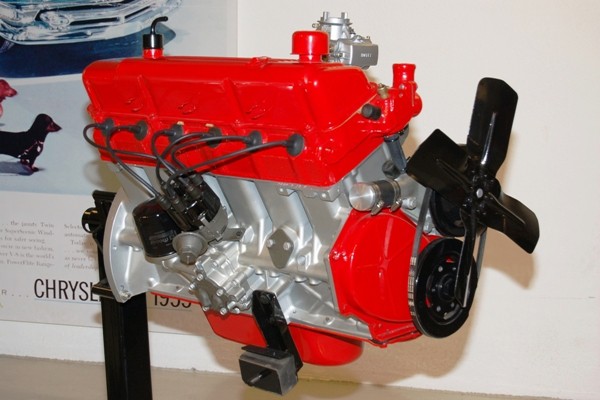 Between
1961 and 1963, Chrysler produced more than 50,000 Slant 6 engines using
an advanced die-cast aluminum block. Manufactured only in the
raised-deck 225 CID version, this piece proved to be somewhat more
trouble-prone than the standard iron block, with cast-in-place ferrous
cylinder liners that tended to separate from the aluminium block
casting. A special head gasket was also required.
Between
1961 and 1963, Chrysler produced more than 50,000 Slant 6 engines using
an advanced die-cast aluminum block. Manufactured only in the
raised-deck 225 CID version, this piece proved to be somewhat more
trouble-prone than the standard iron block, with cast-in-place ferrous
cylinder liners that tended to separate from the aluminium block
casting. A special head gasket was also required.Some of these aluminum blocks also included provisions for hydraulic valve lifters, though they were not so equipped. Sort of an anachronism in this regard, the Slant Six did not adopt hydraulic valve lifters until 1981. All previous versions employed old-fashioned solid lifters that required periodic adjustment.
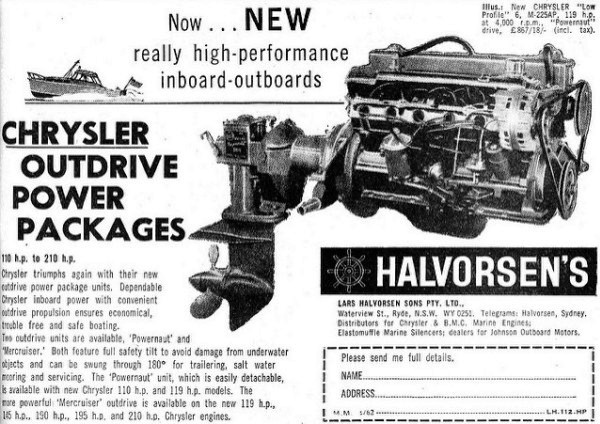 Quickly
developing a reputation for ruggedness and dependability, the Slant 6
was soon adapted to all sorts of marine, industrial, and agricultural
applications—they could turn up almost anywhere. This Australian
advertisement shows a 225 CID, 119 hp Slant 6 paired to a Chrysler
Marine outdrive unit. Slant 6 Chryslers are also commonly found powering
portable welders, self-propelled combines, and irrigation pumps. Many
are still in operation today.
Quickly
developing a reputation for ruggedness and dependability, the Slant 6
was soon adapted to all sorts of marine, industrial, and agricultural
applications—they could turn up almost anywhere. This Australian
advertisement shows a 225 CID, 119 hp Slant 6 paired to a Chrysler
Marine outdrive unit. Slant 6 Chryslers are also commonly found powering
portable welders, self-propelled combines, and irrigation pumps. Many
are still in operation today.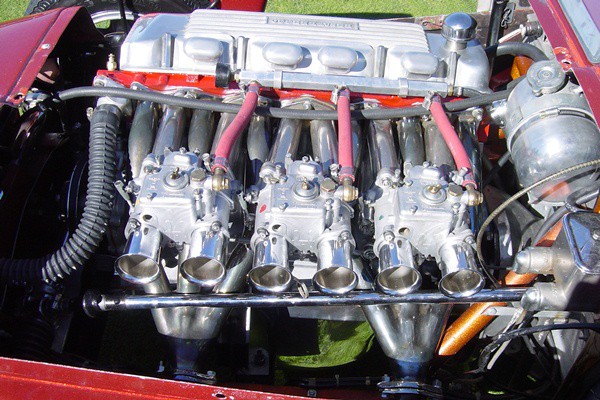 While not a performance engine per se,
the Slant 6 did find its way into a number of performance applications.
Here’s the installation in Tex Smith’s famed XR6 hot rod, winner of the
1963 AMBR Award, which sports three Weber sidedraft carbs and
fabricated tubular headers. (Read the feature here.)
While not a performance engine per se,
the Slant 6 did find its way into a number of performance applications.
Here’s the installation in Tex Smith’s famed XR6 hot rod, winner of the
1963 AMBR Award, which sports three Weber sidedraft carbs and
fabricated tubular headers. (Read the feature here.)Chrysler offered the Hyper-Pak, an over-the-counter performance package sold by Dodge and Plymouth dealer parts departments. The setup included a long-ram intake manifold, special exhaust manifolds, domed pistons, and a special camshaft, boosting the output of the 170 CID Slant 6 to 148 hp or more. Updated versions of the trick pieces are now available in the performance aftermarket.
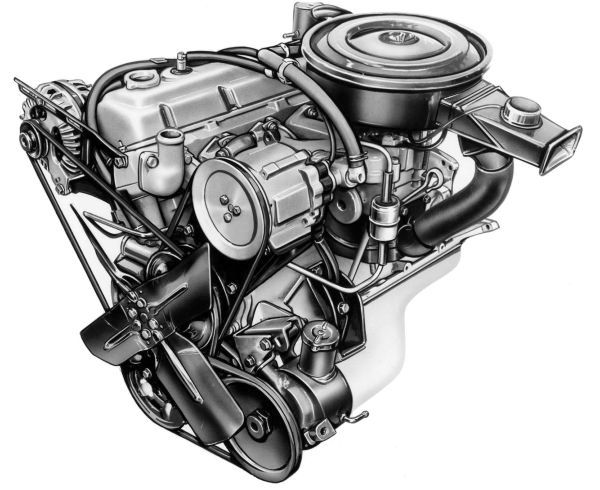 The
Slant 6 was continually updated throughout the ’70s and ’80s—this later
version sports a thermostatic air cleaner, air injection pump, EGR
valve, and other familiar hardware of the Detroit emissions era. The
venerable engine handled the modifications well, though they didn’t do
the net output any good. In 1974 a 198 CID version (destroked for fuel
economy) was introduced, and in 1977-78 there was a 225 CID Super Six
variant that boasted a Carter two-barrel carburetor for a little extra
punch.
The
Slant 6 was continually updated throughout the ’70s and ’80s—this later
version sports a thermostatic air cleaner, air injection pump, EGR
valve, and other familiar hardware of the Detroit emissions era. The
venerable engine handled the modifications well, though they didn’t do
the net output any good. In 1974 a 198 CID version (destroked for fuel
economy) was introduced, and in 1977-78 there was a 225 CID Super Six
variant that boasted a Carter two-barrel carburetor for a little extra
punch.One of the longer-running engine families of the era, the Slant 6 remained in production until 1983 in passenger cars and until 1987 in trucks, and not until 1991 was the engine finally discontinued in industrial applications. Thus closed the book on one of Detroit’s most beloved engines.
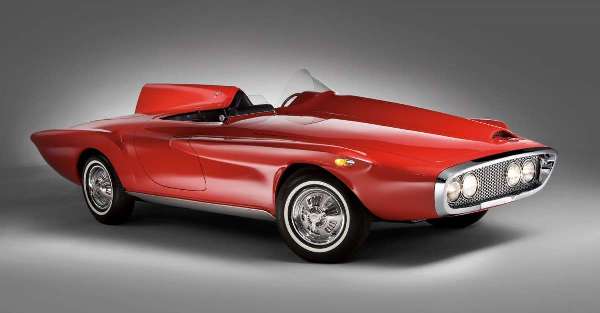 An
interesting footnote to the Slant 6 story: Not many Detroit concept
cars are motivated by a new engine design, but in 1960, Chrysler vice
president of styling Virgil Exner created the Plymouth XNR prototype
sports car. The concept’s unusual asymmetric design elements were
directly inspired by the Slant 6’s offset engine configuration. This
photo, as well as the photo of the XNR’s engine that leads this feature,
are courtesy of RM Sotheby’s.
An
interesting footnote to the Slant 6 story: Not many Detroit concept
cars are motivated by a new engine design, but in 1960, Chrysler vice
president of styling Virgil Exner created the Plymouth XNR prototype
sports car. The concept’s unusual asymmetric design elements were
directly inspired by the Slant 6’s offset engine configuration. This
photo, as well as the photo of the XNR’s engine that leads this feature,
are courtesy of RM Sotheby’s.

This comment has been removed by the author.
ReplyDelete